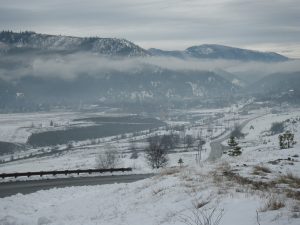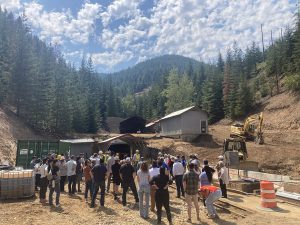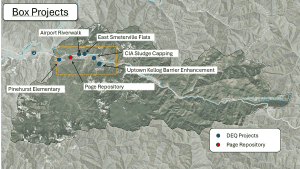THE DIRT: Understanding Permits for Working Near Water in the Coeur d’Alene Basin

Working near water in the Coeur d’Alene Basin often requires obtaining one or more permits, particularly when wetlands are involved. These permits ensure that restoration, construction or development activities are carried out responsibly to protect aquatic ecosystems, water quality and public resources. This article gives a summary of key permits commonly required, with a focus on activities affecting wetlands.
Wetland-related activities: Section 404 and 401 Permits
A critical permit for projects impacting wetlands, or any Waters of the United States, is the Section 404 Permit, administered by the U.S. Army Corps of Engineers (ACOE). This permit is required when dredged or fill material is discharged into rivers, lakes, streams or wetlands. Wetlands are considered protected due to their essential roles in water filtration, flood control and habitat provision.
A Section 404 Permit typically includes conditions from a 401 Water Quality Certification, issued by the Idaho Department of Environmental Quality (DEQ), Coeur d’Alene Tribe or EPA, depending on the project’s location. This certification ensures that the proposed activity complies with state or tribal water quality standards.
Application for these permits is streamlined through a Joint Application Form (between Idaho Department of Lands (IDL), Idaho Department of Water Resources (IDWR), and ACOE), which covers multiple regulatory requirements. Fees vary. General (Nationwide) permits are often free, while individual permits may cost $10–$100.
Other permits for working near water
· Idaho Stream Channel Alteration Permit: Required for any activity that alters the shape, direction, or flow of a stream. This applies to material removal or placement within the high-water mark. Issued by the Idaho Department of Water Resources (IDWR), the permit costs $20.
· Encroachment Permits: These are necessary for structures such as docks, pilings and bank stabilization along navigable waters, including Lake Coeur d’Alene and its rivers. Issued by the IDL, IDWR or the Coeur d’Alene Tribe (for projects within reservation boundaries including dredge and/or fill), these permits may also be obtained through the Joint Application Form between IDL, IDWR and ACOE.
· Floodplain Development Permits: In areas like Shoshone and Kootenai counties, work in designated floodplains requires a local permit to ensure compatibility with flood management standards. FEMA No-Rise Certifications may be required for any project in a floodway and must be reviewed to determine if the project will increase flood heights. An engineering analysis must be conducted before a permit can be issued. The community’s permit file must have a record of the results of this analysis, which can be in the form of a No-Rise Certification. This No-Rise Certification must be supported by technical data and signed by a registered professional engineer. The supporting technical data should be based on the standard step-backwater computer model used to develop the 100-year floodway shown on the Flood Insurance Rate Map (FIRM) or Flood Boundary and Floodway Map (FBFM).
· Site Disturbance Permits: Counties such as Kootenai and Benewah may require these for grading, excavation or drainage work to protect against erosion and sedimentation. Shoshone County also requires Site Disturbance permits for waterfront and upland disturbance projects, which are typically considered high-risk and require a professional design plan. For areas within the Bunker Hill Superfund Site, an Institutional Controls Permit is also required. These permits are free of charge.
· Construction General Permit: Required for projects disturbing over 1 acre of land and discharging stormwater to U.S. waters. Managed by EPA and DEQ, it involves preparing a Stormwater Pollution Prevention Plan (SWPPP) and submitting a Notice of Intent. SWPPP’s must be displayed on the project site and visible for inspection throughout the life of the project.
· Water Rights Permits: Required for temporary or permanent diversion or impoundment of surface or groundwater. Managed by IDWR, these permits ensure legal use and sustainable water allocation. This permit is required for pulling water from area waterbodies for irrigation and drilling wells for domestic water use.
These permits are not just bureaucratic requirements; they play a crucial role in protecting water resources, especially in sensitive areas like wetlands. Applicants are encouraged to coordinate with the appropriate agencies early in project planning to ensure compliance and avoid costly delays, fines or other penalties.






